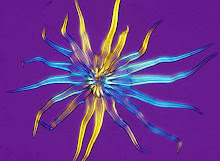 ( These fossil corals are in the drystone wall near the Packhorse Bridge that you can see in the bottom photo at http://cabinetofcuriosities-greenfingers.blogspot.com/2009/08/scotch-argus-butterflies-south-of.html)
( These fossil corals are in the drystone wall near the Packhorse Bridge that you can see in the bottom photo at http://cabinetofcuriosities-greenfingers.blogspot.com/2009/08/scotch-argus-butterflies-south-of.html)


 Hard to believe at first sight, but the limestone ridges in Ravenstonedale in Cumbria that the kestrel (in the bottom photo – click to enlarge) was hunting over were once the beds of warm shallow seas somewhere near the equator back in the Carboniferous period, over 280 million years ago. The evidence is there to see in the form of fossils in the drystone walls, built from limestone boulders, that criss-cross the valley that Scandal Beck has carved out from the limestone. The fossils in the stones are corals called Siphonodendron, whose tentacles would have swayed in ocean currents. At the time when these animals were alive small early reptiles were beginning to evolve and giant dragonflies hunted through steamy swamps. The first flowers, that are such a conspicuous feature of these limestone grasslands today, would not put in an appearance for another 150 million years.
Hard to believe at first sight, but the limestone ridges in Ravenstonedale in Cumbria that the kestrel (in the bottom photo – click to enlarge) was hunting over were once the beds of warm shallow seas somewhere near the equator back in the Carboniferous period, over 280 million years ago. The evidence is there to see in the form of fossils in the drystone walls, built from limestone boulders, that criss-cross the valley that Scandal Beck has carved out from the limestone. The fossils in the stones are corals called Siphonodendron, whose tentacles would have swayed in ocean currents. At the time when these animals were alive small early reptiles were beginning to evolve and giant dragonflies hunted through steamy swamps. The first flowers, that are such a conspicuous feature of these limestone grasslands today, would not put in an appearance for another 150 million years. 






















Something a lot of people would have passed by Phil, and probably not even noticed, let alone know its history.
ReplyDeleteI found that very interesting.
Hi Keith,It's amazing how many interesting fossils turn up in drystone walls.
ReplyDelete